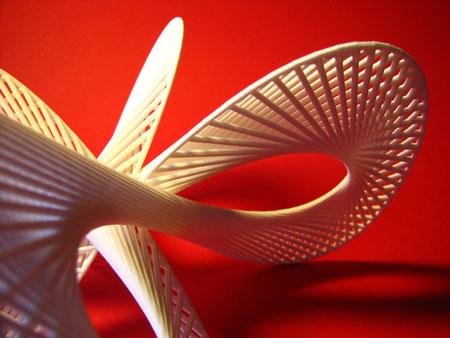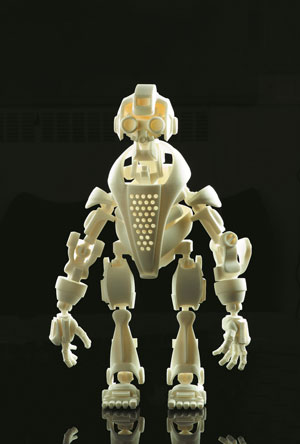| Aug 28, 2013 |
3D printing market is booming as the buzz catches on
|
|
(Nanowerk News) 3D printing stocks jumped early this week following analyst Kenneth Wong’s assertion that the market could triple in the next five years. But why the sudden attention?
|
|
The possible economic impact of 3D printing is indeed significant. Currently, the size of the industry for 3D printing equipment and services is estimated at around £1.43 billion per year. Annual industry growth has been around 30% over the past few years, which means the 3D printing industry is still relatively small, but growing fast.
|
|
What’s catching the attention of many industry analysts is the potential size of the market. In a recent survey conducted by a leading industry observer, several experts were asked to speculate on how many of the potential users of the technology have already adopted it. The answers ranged from 1% to 8%. This suggests there is still an extremely large market opportunity ahead.
|
 |
| Cheap construction of intricate designs. (Image: fdecomite)
|
|
The buzz is overdue
|
|
The pace of this now appears to be increasing. The term “3D printing” has only recently developed into a real buzzword since the media started to cover it on a regular basis. The wider public is now aware of a genuinely different approach to making things. This was certainly overdue, as the first commercially available 3D printers, or “Additive Manufacturing” systems, as they are known in engineering circles, have been available since the late 1980s.
|
|
For those who are involved with the technology, this comes with a great degree of satisfaction. We are now able to share the experience of designing objects on our computers and then building them using a 3D printer in a matter of hours. Much of the excitement comes from the fact that there aren’t many restrictions on what can be made. Often, the designer’s imagination is the limit.
|
|
Cartoons, jet engines and laser beams
|
|
Many different products have already been made using 3D printing; they range all the way from small plastic cartoon characters to high value engineering products such as medical implants.
|
|
Essentially, all 3D printing processes are based on the same principle: raw material is deposited layer-by-layer, effectively building up objects in thin horizontal slices. There are many different types of 3D printing processes. Some are expensive and elaborate machines that use laser beams or complex material jetting heads. Other systems are designed to be simple and cheap enough for the home user, containing not much more than a computer-controlled extrusion nozzle for plastic materials.
|
|
The technology is capable of creating geometrically complex products and components, and is able to do so efficiently in small numbers, sometimes down to a single unit. This is possible because 3D printing works entirely without moulding tools, dies or cutting implements. Such tools are normally costly and time consuming to make, and also limit the shapes that can be manufactured.
|
 |
| 3D printed model of a robot manufactured in a single build. (Image: University of Nottingham)
|
|
The resulting freedom of geometry enables the users of 3D printers to flexibly and efficiently manufacture advanced and functional products. These products may also be optimised for a given purpose, and therefore perform better than their conventionally manufactured counterparts. Naturally, companies that manufacture products for demanding applications, such as jet engines or medical implants, are very interested in using the technology.
|
|
Drawbacks
|
|
It’s important to note that the currently available 3D printing systems differ quite strongly in their capabilities. While some systems aimed at industrial users are able to create durable end-use components, the parts made using low-cost 3D printers are not normally considered tough enough for everyday use.
|
|
Further disadvantages of most 3D printers are the limited choice of build materials and low accuracy, and the poor reliability of the process in general. Where parts are needed in large numbers, the per-unit cost of 3D printed parts may also be significantly higher than in conventional manufacturing; this applies in particular to industrial 3D printing systems. Ongoing technological development is however likely to result in more efficient systems that will be cost competitive in an increasing number of applications.
|
|
Combined, these current technological drawbacks suggest that the commercial use of 3D printing is still limited to the manufacture of high value parts, customised products and prototypes. For many cost-sensitive applications, industrial 3D printing processes are simply too expensive at the present state of technology. Despite receiving significant media attention, the market share of low-cost 3D printers aimed at private users is still quite small. These systems are responsible for around only 6% of the overall industry turnover. This market segment, mainly catering to private hobbyists, is currently growing slightly faster than the industry overall, so its relative share is expected to increase moderately.
|
|
Going mainstream
|
|
For 3D printing to enter the mainstream of manufacturing technology, the biggest challenge will therefore be to reduce the costs associated with using the technology. This is likely to be achieved by speeding the machines up significantly. Faster industrial 3D printing systems are currently under development in several countries and it is expected that these will become available over the coming years.
|
|
Given that the necessary research and development investments are made, the technology’s ability to manufacture highly functional designs is indeed set to revolutionise the global manufacturing industry, as the finance sector now seems to have understood. This will lead to a new generation of products that will change the way we think about manufacturing.
|


